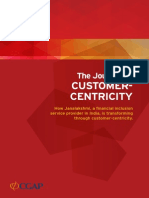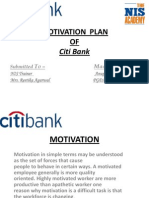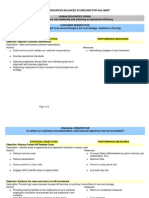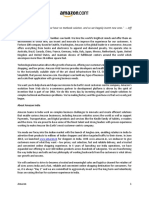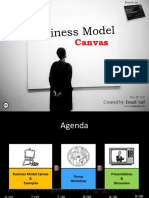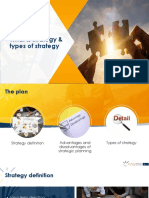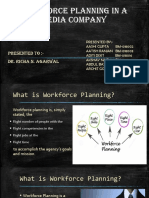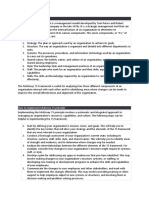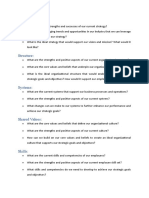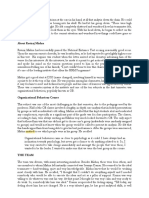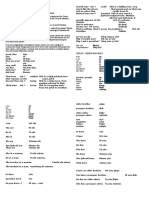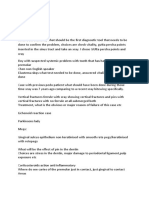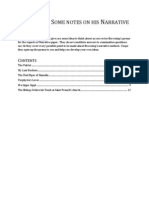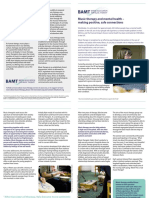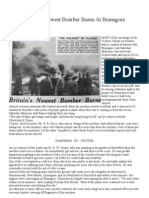The Business Model Canvas is a strategic management tool that allows businesses to visually map
out and describe their business models. It consists of nine key elements that are essential for
creating and sustaining a successful business:
1. Customer Segments: The different groups of customers that a business serves or targets.
2. Value Proposition: The unique value that a business offers to its customers.
3. Channels: The different ways in which a business communicates with and delivers value to
its customers.
4. Customer Relationships: The types of relationships a business has with its different
customer segments.
5. Revenue Streams: The ways in which a business generates revenue from its customer
segments.
6. Key Resources: The essential resources required to deliver the value proposition.
7. Key Activities: The critical activities required to create and deliver the value proposition.
8. Key Partnerships: The strategic alliances and partnerships required to deliver the value
proposition.
9. Cost Structure: The costs associated with operating the business and delivering the value
proposition.
The Business Model Canvas is a powerful tool for businesses to use when developing their
business strategies. It allows businesses to think holistically about their business models, identify
areas where they can improve, and create a framework for continuous innovation and growth.
Dos and Donts of the Busniess model canvs
Here are some dos and don'ts of using the Business Model Canvas:
Dos:
1. Do use the Business Model Canvas to create a clear and concise overview of your
business model.
2. Do collaborate with your team and stakeholders to ensure everyone has a shared
understanding of your business model.
3. Do use the Business Model Canvas to identify strengths and weaknesses in your business
model and make adjustments as needed.
4. Do update your Business Model Canvas regularly as your business evolves and changes.
5. Do focus on creating a unique value proposition that meets the needs of your target
customer segments.
6. Do consider the impact of external factors such as market trends, competition, and
regulatory changes on your business model.
Don'ts:
1. Don't use the Business Model Canvas as a one-time exercise and forget about it. It should
be an ongoing tool to help guide your business.
2. Don't assume that the Business Model Canvas will provide all the answers to your
business challenges. It is just one tool in a larger toolkit.
� 3. Don't neglect to consider the costs associated with your business model. Make sure you
have a clear understanding of your cost structure.
4. Don't overlook the importance of your customer relationships. Build strong relationships
with your customers to ensure their satisfaction and loyalty.
5. Don't forget to consider the impact of your key partners and resources on your business
model. They are critical to your success.
6. Don't be afraid to experiment and iterate on your business model. Use the Business
Model Canvas to test new ideas and pivot as needed.
practibality of the Business model canvas
The Business Model Canvas is a practical tool for designing and refining a business model. It has
gained widespread adoption among entrepreneurs, startups, and established businesses because
of its simplicity, flexibility, and effectiveness in generating insights and actionable ideas. Here are
some reasons why the Business Model Canvas is practical:
1. Easy to use: The Business Model Canvas is a visual and intuitive tool that can be easily
understood and used by people with different levels of business knowledge and
experience. It provides a simple framework for organizing and communicating complex
business concepts.
2. Comprehensive: The Business Model Canvas covers all the key elements of a business
model, including customer segments, value proposition, revenue streams, cost structure,
and more. It encourages a holistic and integrated approach to business design.
3. Flexible: The Business Model Canvas is adaptable to different types of businesses,
industries, and contexts. It can be customized to fit the specific needs and goals of a
business, and can be used in various stages of business development, from ideation to
implementation.
4. Collaborative: The Business Model Canvas is a collaborative tool that can be used by
teams to share ideas, perspectives, and feedback. It facilitates communication, alignment,
and collaboration among stakeholders.
5. Iterative: The Business Model Canvas is an iterative tool that allows for continuous
improvement and refinement of a business model. It encourages experimentation,
testing, and learning, and enables a feedback loop between the business and its
environment.
Overall, the Business Model Canvas is a practical tool for businesses of all sizes and stages of
development. It can help entrepreneurs and managers to better understand their customers,
create value, generate revenue, manage costs, and ultimately, achieve sustainable growth and
profitability.
Practical examples of Business canvas model
Here are some practical examples of the Business Model Canvas being used in various industries
and contexts:
1. Airbnb: Airbnb is an online marketplace that connects hosts with travelers looking for
unique accommodations. Their Business Model Canvas includes customer segments
� (travelers, hosts), value proposition (unique travel experiences, extra income for hosts),
channels (website, mobile app), customer relationships (community building, trust),
revenue streams (service fees, commission), key resources (technology, brand), key
activities (marketing, platform development), key partnerships (host community, payment
providers), and cost structure (marketing, customer service).
2. Uber: Uber is a transportation network company that provides ride-hailing services
through a mobile app. Their Business Model Canvas includes customer segments (riders,
drivers), value proposition (convenience, affordability), channels (mobile app, website),
customer relationships (reliable service, safety), revenue streams (ride fees, commission),
key resources (technology, brand), key activities (driver recruitment, platform
development), key partnerships (payment providers, auto manufacturers), and cost
structure (marketing, legal).
3. Tesla: Tesla is an electric vehicle and energy company that designs and manufactures
high-performance cars and sustainable energy products. Their Business Model Canvas
includes customer segments (EV enthusiasts, environmentally conscious consumers),
value proposition (innovative technology, sustainability), channels (showrooms, online),
customer relationships (brand loyalty, customer service), revenue streams (car sales,
energy products), key resources (technology, manufacturing), key activities (R&D,
production), key partnerships (suppliers, charging networks), and cost structure (R&D,
production).
4. Netflix: Netflix is a streaming service that offers a wide selection of TV shows, movies, and
original content to subscribers. Their Business Model Canvas includes customer segments
(streaming subscribers), value proposition (wide selection, personalized
recommendations), channels (streaming platform, mobile app), customer relationships
(personalization, convenience), revenue streams (subscription fees), key resources
(content, technology), key activities (content acquisition, platform development), key
partnerships (content creators, ISPs), and cost structure (content licensing, R&D).
These are just a few examples of how the Business Model Canvas can be used to describe and
analyze different types of businesses. The canvas is a versatile tool that can be customized to fit
the specific needs and goals of any business.





